Fish Killer tree, Beach Barringtonia
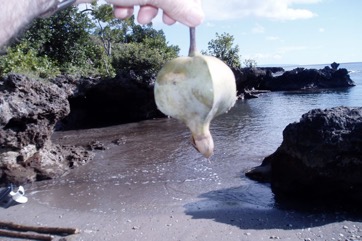
A tropical plant. They occur along the seashore throughout the islands of Asia and the Pacific. Trees often lean out over the sea. It prefers well-composted, moist, well-drained soil. It can grow easily in sandy soil. It can tolerate salty soils. It suits a protected sunny position. It is drought and frost tender. It suits hardiness zones 11-12.
Also known as:
Bitung, Botong, Butun, Fish Poison Tree, Futu, Hotu, Hutu, Keben, Keiengal, Kimbi, Kinbi, Kyi-gyi, Motong-botong, Navel, Pertun, Putat ayer, Putat gajah, Putat laut, Puteng, Queens of shores, Reang, Sea putat, Te baireati, Vutu, Waap, Waba, Waiep, Wan bibi
Synonyms
- Agasta asiatica (L.) Miers
- Agasta indica Miers
- Agasta splendida Miers
- Barringtonia butonica J. R. Forst. & G. Forst.
- Barringtonia levenquii Jardin
- Barringtonia littorea Oken
- Barringtonia senequei Jard.
- Barringtonia speciosa J. R. & G Forst.
- Barringtonia speciosa L. f.
- Butonica speciosa (J. R. Forst. & G. Forst.) Lam.
- Commersonia speciosa (J. R. Forst. & G. Forst.) Britten
- Doxomma magnificum Miers
- Huttum speciosum (J. R. Forst. & G. Forst.) Britten
- Mammea asiatica L.
- Michelia asiatica (L.) Kuntze
- Mitraria commersonia J. F. Gmel.
Edible Portion
- Leaves, Pods, Seeds, Fruit, Flowers, Caution
Where does Fish Killer tree grow?
Found in: Africa, American Samoa, Andamans, Asia, Australia, British Indian Ocean Terr., BIOT, Cambodia, Carolines, Chuuk, Comoros, Cook Islands, Dominican Republic, East Africa, East Timor, Fiji, French Polynesia, FSM, Hawaii, India, Indochina, Indonesia, Japan, Kiribati, Madagascar, Malaysia, Maldives, Mariana Islands, Marquesas, Mascarenes, Mauritius, Micronesia, Mozambique, Myanmar, New Caledonia, Pacific, Palau, Papua New Guinea, PNG, Philippines, Philippines, Rotuma, Samoa, SE Asia, Seychelles, Singapore, Solomon Islands, Sri Lanka, Taiwan, Tahiti, Thailand, Timor-Leste, Tonga, Tuvalu, United States, Vanuatu, Vietnam, Wallis and Futuna, West Indies
Notes: The seeds are used as a fish poison due to a chemical saponin. There are about 40 Barringtonia species. The seeds contain Hydrocyanic acid and triterpene acids.
Status: It is not known if it is used for food in Papua New Guinea. A very minor food.
Growing Fish Killer tree, Beach Barringtonia
Cultivation: Plants can be grown from cuttings or seed. Seed need to be sown fresh. Seed germinate readily. Young trees need shade. Plants can be grown by layering.
Edible Uses: The young leaf shoots may be eaten fresh. The young flowers are also eaten. The young fruit have been recorded eaten as a vegetable. Cooking destroys the saponins. CAUTION This plant is used as a fish poison. They contain saponins. The seeds are oily and toxic. They have been recorded as being cooked and eaten in Indonesia and the Andaman Islands.
Production: Seed take up to 2 months to germinate but seedlings grow very quickly.
Nutrition Info
per 100g edible portion| Edible Part | Energy (kcal) | Protein (g) | Iron (mg) | Vitamin A (ug) | Vitamin c (mg) | Zinc (mg) | % Water |
|---|---|---|---|---|---|---|---|
| Leaves | - | - | - | - | - | - | |
| Pods | - | - | - | - | - | - |
Fish Killer tree, Beach Barringtonia Photos

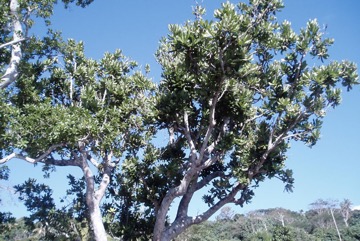
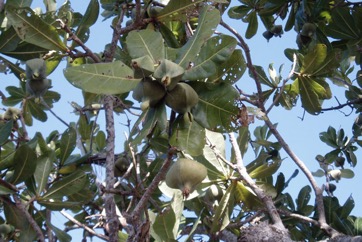
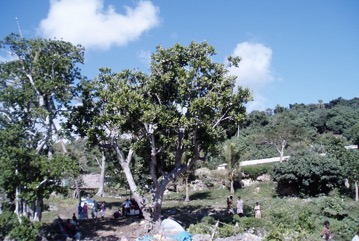
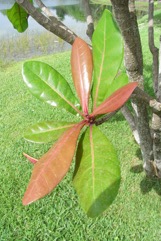
References
Ambasta S.P. (Ed.), 2000, The Useful Plants of India. CSIR India. p 68
Barwick, M., 2004, Tropical and Subtropical Trees. A Worldwide Encyclopedic Guide. Thames and Hudson p 43
Bhargava, N., 1983, Ethnobotanical Studies of the Tribes of Andaman and Nicobar Islands, India. 1. Onge. Economic Botany 37(1): 110-119
Bircher, A. G. & Bircher, W. H., 2000, Encyclopedia of Fruit Trees and Edible Flowering Plants in Egypt and the Subtropics. AUC Press. p 54 (Also as Barringtonia butonica)
Bodkin, F., 1991, Encyclopedia Botanica. Cornstalk publishing, p 133
Burkill, I.H., 1966, A Dictionary of the Economic Products of the Malay Peninsula. Ministry of Agriculture and Cooperatives, Kuala Lumpur, Malaysia. Vol 1 (A-H) p 306
Cabalion, P. and Morat, P., 1983, Introduction le vegetation, la flore et aux noms vernaculaires de l'ile de Pentcoste (Vanuatu), In: Journal d'agriculture traditionnelle et de botanique appliquee JATBA Vol. 30, 3-4
Cooper, W. and Cooper, W., 2004, Fruits of the Australian Tropical Rainforest. Nokomis Editions, Victoria, Australia. p 266
Cowie, I, 2006, A Survey of Flora and vegetation of the proposed Jaco-Tutuala-Lore National Park. Timor-Lests (East Timor) www.territorystories.nt/gov.au p 49
Cundall, P., (ed.), 2004, Gardening Australia: flora: the gardener's bible. ABC Books. p 220
Dobriyal, M. J. R. & Dobriyal, R., 2014, Non Wood Forest Produce an Option for Ethnic Food and Nutritional Security in India. Int. J. of Usuf. Mngt. 15(1):17-37
Elliot, W.R., & Jones, D.L., 1982, Encyclopedia of Australian Plants suitable for cultivation. Vol 2. Lothian. p 306
Engel, D.H., & Phummai, S., 2000, A Field Guide to Tropical Plants of Asia. Timber Press. p 73
Etherington, K., & Imwold, D., (Eds), 2001, Botanica's Trees & Shrubs. The illustrated A-Z of over 8500 trees and shrubs. Random House, Australia. p 119
Flora of Australia, Volume 8, Lecythidales to Batales, Australian Government Publishing Service, Canberra (1982) p 4
Franklin, J., Keppel, G., & Whistler, W., 2008, The vegetation and flora of Lakeba, Nayau and Aiwa Islands, Central Lau Group, Fiji. Micronesica 40(1/2): 169–225, 2008
Havel, J.J., 1975, Forest Botany, Volume 3 Part 2 Botanical taxonomy. Papua New Guinea Department of Forests, p 225
Hearne, D.A., & Rance, S.J., 1975, Trees for Darwin and Northern Australia. AGPS, Canberra p 30
Hedrick, U.P., 1919, (Ed.), Sturtevant's edible plants of the world. p 93 (As Barringtonia butonica)
Henty, E.E., 1980, Harmful Plants in Papua New Guinea. Botany Bulletin No 12. Division Botany, Lae, Papua New Guinea. p 26
Hinton, B & B., 1982, A Wilderness in Bloom. Wildflowers of tropical Australia. p 41
Lazarides, M. & Hince, B., 1993, Handbook of Economic Plants of Australia, CSIRO. p 31
Liefting, A., et al, Samoan plant names. http://en.wikipedia.org
MARDI Malaysia
Martin, F.W. & Ruberte, R.M., 1979, Edible Leaves of the Tropics. Antillian College Press, Mayaguez, Puerto Rico. p 197
Menninger, E.A., 1977, Edible Nuts of the World. Horticultural Books. Florida p 38 (As Barringtonia butonica)
Monsalud, M.R., Tongacan, A.L., Lopez, F.R., & Lagrimas, M.Q., 1966, Edible Wild Plants in Philippine Forests. Philippine Journal of Science. p 485
Nicholson, N & H., 1994, Australian Rainforest Plants 4, Terania Rainforest Publishing. NSW. p 15
Phon, P., 2000, Plants used in Cambodia. © Pauline Dy Phon, Phnom Penh, Cambodia. p 88
Prance. G. T., 2013, A revision of Barringtonia (Lecythidaceae). Allertonia 12:1-164
Prance, G. T. & Jongkind, C. H., 2015, A Revision of African Lecythidaceae. Kew Bulletin. 70:1-68
Prelim. rep. forest Pegu., App. A:lxv, App. B:65. 1875
Schatz, G.E., 2001, Generic Tree Flora of Madagascar. Royal Botanical Gardens, Kew and Missouri Botanical Garden. p 230
Selvam, V., 2007, Trees and shrubs of the Maldives. RAP Publication No. 2007/12 p 40
Staples, G.W. and Herbst, D.R., 2005, A tropical Garden Flora. Bishop Museum Press, Honolulu, Hawaii. p 369.
Stone, B.,
Sujanapal, P., & Sankaran, K. V., 2016, Common Plants of Maldives. FAO & Kerala FRI, p 52
Sukarya, D. G., (Ed.) 2013, 3,500 Plant Species of the Botanic Gardens of Indonesia. LIPI p 148
Swaminathan, M.S., and Kochnar, S.L., 2007, An Atlas of major Flowering Trees in India. Macmillan. p 287
Thaman, R. and W. Clarke, Paper on Agroforestry on Aneityum and Tanna, Vanuatu from Internet
Thaman, R. R, 2016, The flora of Tuvalu. Atoll Research Bulletin No. 611. Smithsonian Institute p 71
Thitiprasert, W., et al, 2007, Country report on the State of Plant Genetic Resources for Food and Agriculture in Thailand (1997-2004). FAO p 95
Townsend, K., 1994, Across the Top. Gardening with Australian Plants in the tropics. Society for Growing Australian Plants, Townsville Branch Inc. p 98
Wickens, G.E., 1995, Edible Nuts. FAO Non-wood forest products. FAO, Rome. p 139
World Checklist of Useful Plant Species 2020. Royal Botanic Gardens, Kew
Yuncker, T.G., 1959, Plants of Tonga, Bernice P. Bishop Museum, Hawaii, Bulletin 220. p 196
Zawiah, N. & Othaman, H., 2012, 99 Spesies Buah di FRIM. Institut Penyelidikan Perhutanan Malaysia. p 64